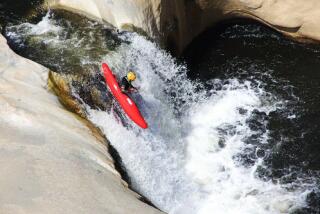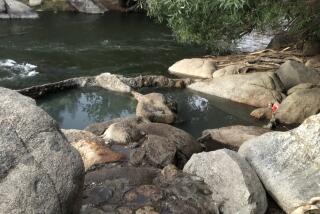A rare but nasty risk with that natural soak
- Share via
The hike is long and dusty, across two miles of shrub-strewn desert, south of Apple Valley.
But Lisa Fernandez, a Web designer and hot springs enthusiast, has often made the trek from the trail head to the pools of steaming water. She believes the payoff is worth it: a day of soaking in undeveloped, natural hot springs in the shade of pine and willow trees at the foot of the San Bernardino Mountains.
The naturally heated water at the Deep Creek Hot Springs increases her heart rate, soothes her tense muscles and, she says, detoxifies her skin. “I just love it,” she said.
But just as nature lovers swarm to Deep Creek and other rustic hot-water oases to stave off the chills of winter, a spate of tainted-water fatalities and related studies have raised questions about the health risks of soaking in hot springs.
In April, the federal Centers for Disease Control and Prevention assigned a team of scientists and physicians to study a recent spike in deaths caused by Naegleria flowleri, an amoeba found naturally in bodies of warm fresh water, such as lakes and hot springs. The group was formed in response to six deaths in 2007 in Arizona, Florida and Texas, all attributed to the amoeba, which typically enters the body through the nasal passages and then attacks brain tissue.
Infections are almost always fatal. Between 1998 and 2007, the U.S. recorded 33 cases; all but one was fatal, according to the CDC. The six deaths in 2007 represented the sixth-highest annual number of cases in the last 70 years.
Locally, anxiety over the infection grew when Naegleria fowleri claimed another victim this summer, a 9-year-old boy, who officials believe contracted the amoeba while swimming in Lake Elsinore in Riverside County.
--
An ’07 spike in cases
The recent CDC research could not explain what caused the spike in Naegleria flowleri cases in 2007. And the group warned that, although the number of infections has been relatively low compared with the millions of swimmers who enter warm freshwater pools each year, scientists still don’t know why certain people get infected and what concentration of amoeba in the water poses a significant risk. The CDC group recommended public health agencies disseminate more information on the infection to potential swimmers.
In a separate study conducted in 2003 by Montana State University, researchers tested the waters at 23 hot springs in Yellowstone and Grand Teton national parks and found Naegleria flowleri and other amoebas present in the hot-water pools.
The study concluded that the amoeba is not a transient organism but rather thrives in some hot springs. “These amoebae may pose health risks to people who use the hot springs for recreation,” according to the study, published in Applied and Environmental Biology in October 2003.
In fact, three cases of Naegleria fowleri infection (known as primary amoebic meningoencephalitis, or PAM) have been contracted at Fernandez’s favorite hot spring, Deep Creek, since 1971, according to the CDC. The U.S. Forest Service has since posted a sign near the pools, warning about the dangers of the amoeba infection.
Overall, health officials note, the odds of infection from Naegleria fowleri are slim and can be reduced to nearly nil with the proper precautions.
And of the 121 cases (all but one were fatal) of Naegleria fowleri reported in the United States from 1937 to 2007, four have been tied to hot springs, according to the CDC. By comparison, there were more than 36,000 drowning deaths in the U.S. between 1996 and 2005, according to the CDC.
“It’s a very rare disease but obviously deadly,” said Dr. Michael Beach, who co-chaired the CDC working group.
The amoeba can survive in just about the hottest water that humans can tolerate, Beach said. The Deep Creek hot spring usually bubbles up at a steamy 103 degrees.
So why do so many more infections occur after swimming in warm lakes and rivers than in hot springs? Beach points out that the amoeba enters through the nose, and so swimmers who splash or submerge themselves in the water are more likely to get infected. Hot springs enthusiasts typically soak quietly, without submerging their heads.
That was the scene during a recent visit to Deep Creek Hot Springs, where about half a dozen visitors lounged about in one of several natural and artificially deepened pools, near the banks of Deep Creek. The water gurgles up from fissures in a battleship-sized mound of milk-colored boulders. One of the deepest pools was made years ago by volunteers who used river rocks and concrete to form a tub about three feet deep. Other pools are formed where spring water gathers naturally in large, shallow hollows in the rocks. The smallest pools are the hottest and all are clothing-optional.
Fernandez, founder of www .hotspringsenthusiast.com, an online source of maps and other information about hot springs across the U.S., believes the health benefits of soaking in hot springs far outweigh the risks.
Both Fernandez and Beach say bathers can reduce the chances of contracting the amoeba by plugging their nose or wearing nose plugs in a hot spring pool to keep water out of the nasal passages. (Infections do not occur from drinking contaminated water.) But because scientists have yet to determine when the risk of infection is highest, medical experts cannot regulate or enforce a standard to protect swimmers from the infection, according to the CDC report. Tests to determine if Naegleria fowleri exists in a pool of water take weeks to grow and identify the amoeba.
--
Health warnings
After the death of the boy in Riverside County, public health officials issued an advisory, suggesting swimmers take precautions, such as wearing nose clips to reduce the chances of infection. But Riverside County public health officer Eric Frykman said the risk of contracting the amoeba from swimming is so slim that the average person has a higher risk of dying in a car accident while driving to and from a swimming hole.
“The risk is exceptionally low,” he said.
Still, the infection is particularly vicious, coming on with flu-like symptoms such as headaches, a stiff neck, vomiting and fever. Later, the victim can become disoriented and suffer from seizures and hallucinations. Death usually follows within three to seven days after the symptoms appear.
The CDC report concluded with this warning: “The only certain way to prevent Naegleria fowleri infection is to refrain from water-related activities.”
--







